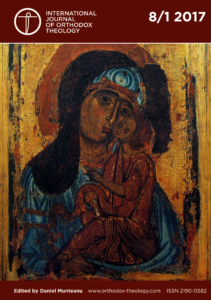Den Ortodokse Kirkes Kalender
 F. diakon Irakli har fået publiceret en dybdegående artikel i tidsskriftet International Journal of Orthodox Theology, nummer 8/1, 2017 med titlen “Historical, Canonical, Mathematical and Astronomical Aspects of the Paschalion Question”.
F. diakon Irakli har fået publiceret en dybdegående artikel i tidsskriftet International Journal of Orthodox Theology, nummer 8/1, 2017 med titlen “Historical, Canonical, Mathematical and Astronomical Aspects of the Paschalion Question”.
An article by f. deacon Irakli with the title of “Historical, Canonical, Mathematical and Astronomical Aspects of the Paschalion Question” was recently published in a a scientific, peer-review and open access journal – International Journal of Orthodox Theology, issue 8/1, 2017.
Abstract:
There are different calendar systems in use among Orthodox Churches worldwide. Non-movable Orthodox Christian feasts like Nativity, Annunciation, Transfiguration, and so on, are celebrated according to two different — Julian and Revised Julian — calendars. However, when it comes to the question of the Easter date, most of the churches with some exception celebrate the feast of the Resurrection of our Lord Jesus Christ on the same Sunday. Despite different calendar systems, it is precisely the Easter date determination question on which all calendar systems are based. Presented paper studies the Easter date (also known as Paschal) related question from historical, canonical, mathematical and astronomical points of view. Two existing paschal systems — Alexandrian and Gregorian — are presented here. According to these systems, the dates of the Easter for the period of 2000 — 2050 are calculated and compared with the astronomical dates defined by the Church canonical requirements for the Easter date determination. Obtained results reveal that the Alexandrian method used in most Orthodox churches often deviate from the astronomical reality and canonical rules, and its accuracy can reach only 31% for the given period of years. On the other hand, the accuracy of the Gregorian method used in the Catholic/Protestant world can be as high as 92%.
